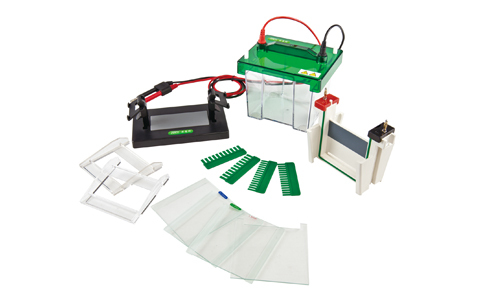Functionally electrophoresis is a technique that consists of proportional migration of molecules through a gel or other type of porous matrix, depending on their molecular weight or size; movement generated by the electric field, i.e. we apply an electric current to molecules whether biological, DNA, protein or RNA, and they are separated according to whether they are larger or smaller.
Generally, most biomolecules have an electrical charge whose magnitude depends on the pH of the medium in which they are found; immediately as a result, the molecules can move when subjected to an electric field to the charge pole opposite that of the molecule. Depending on the molecule, it moves in, out, up, or down the gel.
Molecular process performed by some samples for electrophoresis
- In proteins: you usually take the whole protein to see how big it is. The shorter, the more they migrate into the gel, so that the small proteins will end up at the bottom of the gel, because they’ve gone farther, and the larger ones will end up staying at the top.
- In DNA: It’s a very long molecule, so you can’t make a gel out of an entire molecule of DNA from a cell. It’s so big it would never get into the gel, so what scientists do is cut the DNA with things like restriction enzymes, which cut the DNA into more manageable pieces, and then those pieces, depending on how big they are, migrate more or less through the gel and end up higher or lower.
- nucleic acids only have a negative charge, due to their phosphate skeleton. Therefore, in an electrophoresis, nucleic acids will migrate to the positive pole; that is, the anode. Therefore, it is an important part of the systematic procedure of analysis (separation, purification, preparation) of nucleic acids.
Elements necessary to perform an electrophoresis
- Electrophoresis chamber: is a box that allows the generation of an electric field around a gel where the samples are deposited.
- Gel: medium support, may be agarose or polyacrylamide, acrylamide.
- Agarose gels: it is a polysaccharide extracted from seaweed.
- Acrylamide gels: synthetic, thermostable, colorless and chemically inert polymer.
- Running Buffer: it provides the means for the transmission of electric current and maintains the pH unchanged while the current is being run.
- Molecular weight marker: They are DNA or protein molecules that allow the size of nucleic acid or protein fragments contained in samples subjected to electrophoresis to be determined by comparison.
- Load Buffer: it is a buffer that aims to provide weight, density and color to the sample, which facilitates its deposit in the well and prevents its exit from the gel; it also allows monitoring the flow of the sample in the gel.
- Ultraviolet transiluminator: device that transmits light from the ultraviolet spectrum through the sample, exciting the chromogenic molecule that emits fluorescent energy that allows visualization
Steps consisting of a typical electrophoresis
- Prepare a gel of agarose or acrylamide at the required concentration.
- Mix the samples to be analyzed with a suitable load buffer.
- Load the samples into the gel.
- Perform the electrophoretic run at the relevant voltage.
- Visualize the nucleic acids
In KALSTEIN we offer two lines of electrophoresis, one horizontal that you can know in the following link HERE and a vertical HERE both have similar characteristics of the brand, like quality, technology; have a wide range of tank sizes and trays, as well as many comb options, these systems can handle all kinds of electrophoresis experiments.
Among other aspects corresponding to special processing technology, it effectively guarantees heat dissipation in a more uniform way, maintaining a stable pH during the operation of electrophoresis, among other features that you will discover in our Kalstein Laboratory Equipment Company, with great demand buy-sale worldwide, we offer you online shopping channels in the following link:HERE

